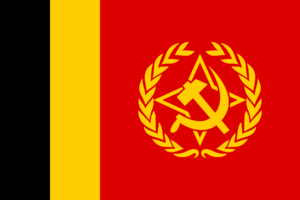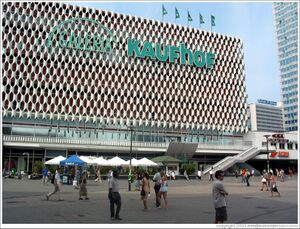Economy of Velaheria
 Flag of Velaheria | |
| Currency | Wran (VW) |
|---|---|
| 1 March — 31 April | |
Trade organisations | None |
| Statistics | |
| GDP | USD 92 billion (PPP, 2021) |
GDP growth | 3.4% (2021) |
GDP per capita | USD 3,123 (PPP, 2021) |
GDP by sector | Services: 30,7% Industry: 42,3% Agriculture: 18,0% |
| 5.6% | |
Population below poverty line | N/A (2021) |
| 0.30 (2021) | |
Labour force | 18 million (2021) |
Labour force by occupation | Services: 32,1% Industry: 40,9% Agriculture: 18,0% |
| Unemployment | 5-7% (2021) |
Main industries | List
|
| External | |
Export goods | List
|
Import goods | List
|
Velaheria has maintained one of the most closed and centralized economies in the wurld since the 1940s. For several decades, it followed the Central pattern of five-year plans with the ultimate goal of achieving self-sufficiency. Extensive communist support allowed Velaheria to rapidly register very high growth rates, However, this has also lead to systematic inefficiencies which are largely visible in the economic production and activities of velaheria.
The State expertises in the production of heavy machinery, metals and minerals which form the backbone of its economy. It also has its fair share of growth through agricultural activities which form a large part of its economy.
Services are a relatively moderate part of the nation, with the average services available being small scaled due to the centralization of policies and the ban on private ownership and existence of large scale state owned companies inside the nation, though several minor small private organization thrive inside the nation's largest cities, due to a general lack of oversight by the government on their activities.
Sectors of Economy
Agriculture
Since 1950's, virtually all of the country's agricultural land has been in the socialist sector (state enterprises or cooperatives).
The basic farming entity since the revolution has been farmers' collective, which are basically collective farms where the lands of some neighbouring individually owned farmers is incorporated and is then farmed to have greater amounts of harvests, however this has also taken a toll on the farmer's morale as not all of them are pleased with the amounts of shares they get out of their produce, with often being unpleased with the results, which has the effects of them relying somewhat on their personal produces from their own private land, whose ownership is guarrenteed by the velaherian constitution.
Collective farms have increased in area by 7 times since 1950. In 2015 there were 1,700 collectives with over 1,000,000 members, There are 256 state farms, which are officially owned and operated by the government employing 206,432 workers, Collective farms hold about 90,000 km² (plus about 120 km² in private plots), and state farms hold 25,000 km², Members of collective farms are permitted to cultivate personal plots of 5,000 m² or less and to maintain some livestock.
Such personal plots reached a peak of popularity in the early 1980s, when they had accounted for 3,600 km², By 1995 their area had decreased to 1,600 km², Production from personal plots is minor and serves primarily as a food source for the cultivator.
All of the farms are nationalized and are used for collective farming. No one can own more than 1 hectare of land, and only for residential purposes, with such ownership being monitored by the VPV, with any signs of holding any personal property can lead to that family being exiled or being persecuted by the government, due to their said actions.
Collectivization has been actively promoted across velaheria, with mass collectivization starting in the early 50's and 60's, this lead to early successes in developing food security and surplus food production, which even lead to the increment of the distribution of calories per person, by 25% in the following years, this system usually required heavy amounts of irrigation and farm labour, with some farmers being forced to work on the collective fields, but that lead to the increase of the general crop production.
Younger workers left for better jobs in the cities and productivity fell. Reforms in the 1970s saw more investment and improvements began to appear gradually, though these developments were subsidised by the labours of the military, who were sometimes asked to perform farming to maintain the production quotas, however this wasnt that much of a success due to the heavy amounts of priority being provided to the velaherian industrial growth and development which saw most of the budget of velaheria being dedicated towards industrial growth and development of consumer goods but not towards the agricultural sectors, which resulted in the subsequent drop in production of crops across velaheria.
There were record harvests in the 1980s, however these quickly decimated due to a result of, terrible climatic changes and droughts, which plagued the southern parts of the nation, and started a three year long famine, which got worsened by the lack of seafood/riverfood, harvests by the fishermen, due to a lack of petroleum imports and a reduced budget, nearly 300,000 people died due to this famine, which only stopped after the 1986-1988 agricultural reforms, done by the government in order to boost agricultural production inside velaheria.
Government policy encourages cooperation and specialization among the various agricultural units. Both informal and formal arrangements exist. Mutual aid in terms of machinery or labor for particular tasks had long been practiced among neighboring farms, and this continues under the collectivized farming system. More formal arrangements took shape in the 1960s and expanded in the 1970s and expanded in the upcoming decades. Many of these took the form of "joint agricultural enterprises," entities that somewhat resembled stock companies. Some cooperative organizations specialize in such activities as fattening of hogs or cattle, production of eggs or drying and production of feed mixtures. Others offer agrichemical, construction, land improvement, or marketing services. A large number engage in multiple activities which tend to increase the harvests of secondary and fodder crops necessary to sustain the farming of animal products and husbandry related goods.
Fishing
Velaherian fisheries export riverfood, primarily crab, to Stedoria and Fravina.
Crabs, clams and conches from the river waters of Velaheria are popular in Stedoria, possibly because the less salty water improves taste.
Industry
Velaheria implements planned economy in industry. The government provides fuel and materials for a factory, while the factory manufactures products and quantities according to the government's requirements. Although this policy has changed since the 1990's as the state budget has gradually seen some distortion and the stratified system of the state run industry was liberalized in favour of the factories, which would now receive their materials from state owned industries at subsidised prices and could determine their own production levels of goods and products, though still with large amounts of government supervision
Velaheria's policy of rapid industrial developmental strategy assigned top priority to developing heavy industry, with parallel development in agriculture and light industry. This policy was achieved mainly by giving heavy industry preferential allocation of state investment funds. More than 50% of state investment went to the industrial sector during the 1943–1965 period, this was done in part due to the ravages that the country faced after the end of the velaherian war of liberation and lost most of its pre war industrial capacity by the end of the war in 1942.
After the fall of socialist states in the late 1980's and early 1990's , The Velaherian state faced a sheer drop in revenues collected by the state and thus wanted to revive its stagnating economic growth by promulgated a joint venture law to attract foreign capital and technology. The new emphasis on expanding trade and acquiring technology was not, However, popular in the minds of the hardline-socialists who advocated that velaheria shouldnt lean so much towards capitalistic tendencies and should instead try to become more self reliant and industrialised in order to attain self sufficiency.
However as a result of declining food productions and increasing amounts of economic stagnation and faliure in terms of fulfilling quotas, Velaheria announced the creation of a Special Economic Zone (SEZ) in the northeast regions of Bersia (Vertian Special Economic Zone). Investment in this SEZ has been adequete and fast as a result of the liberalization of the economy in the early 2000's.
Problems with bureaucracy and corruption have somewhat hindered growth and development. Nevertheless, thousands of small and medium sized rhodellian, iverican and delamerian businesses had set up profitable operations in Velaheria since the late 2000's and early 2010's with ever increasing amounts of investments and joint ventures between the state and these foreign companies as a result of the economic liberalization of velaheria and the adequete transportation facilities there.
Garments Industry
The most successfully growing export industry is the garment industry. Production is by a Velaherian firm for a Iverican firm or other foreign partner, by an Velaherian firm operating in Veleheria with an iverican partner, or by Velaherian workers working in Rhodellian or other foreign factories. Wages are among the lowest in south eastern argis.
Automobiles industry
The Velaherian motor production establishes military, industrial and construction goals, with private car ownership by citizens remaining on medium demand mostly due to the emergence of the new middle classes during the late 90's and the 2000's, However this has still remained on a low front as a result of the economic hardships faced by velaheria in the 2000's due to the food shortages that it faced due to environmental issues. Having dolch origins (the subsequent practice of cloning foreign specimens, and a recent automobile joint-venture), Velaheria has developed a wide-range automotive industry with production of all types of vehicles. The basis for production is in urban and off-road minis; luxury cars; SUV cars; small, medium, heavy, and super-heavy cargo; construction and off-road trucks; minibuses/minivans, coach buses, civilian and articulated buses, trolleybuses, and trams.
Retail
In the early 1990s the official retail sector was mainly state-controlled, under the direction of the Velaherian People's Services Bureau, they ensured to distribute the people the regular day to day consumer goods for their requirement, which was free of any cost, and could be consumed by anyone, despite their wages, though beauracracy made such efforts falter in the early 2000's.
Consumer goods are adequate but of poor quality, with most provided on a ration basis. There are state-run stores and direct factory outlets for the masses, and special shops with luxuries for the elite classes, as well as a chain of hard-currency stores with branches in large cities.
In 2002 and in 2010, private markets were progressively legalized, mostly for food sales, as the state has failed to provide food to the populace on a larger scale, with about 10% of the population facing situations close to malnutrition, though this situation has mostly been handled due the opening of several small food retail stores which, sell food to the people.
As of 2013, urban and farmer markets were held every 10 days, and most urban residents lived within 1 km of a market, which made it easier to acccess those markets and ensured that every person could get access to the basic neccesities of their daily survival.
As of 2014, these malls sold competing brands of goods, for example at least ten different kinds of shampoo are being sold, there were also several types of bicycles, food products and other commodities that were being sold mostly to the elite sections of the society.
In 2019, some independent sources estimated there were 660 government-approved markets employing about 1.6 million people.
Criticism
Corruption
Corruption inside of Velaheria is widespread, this is mainly observed by the fact that even the simplest of actions require's some sort of illegal actions, Corruption is visible in all sections of society, Though the people have largely seemed to have accepted it, partially due to the lack of government's interest to act on such matters.


